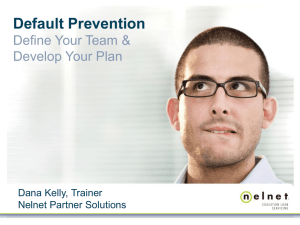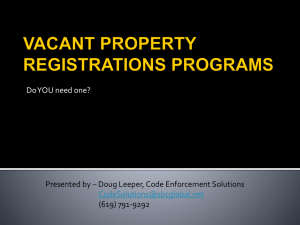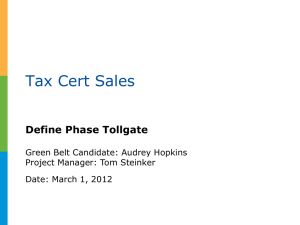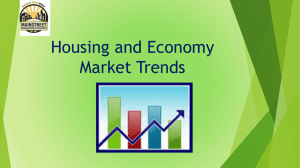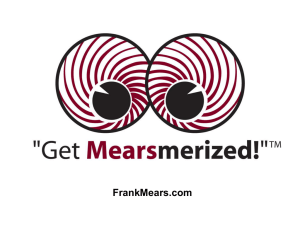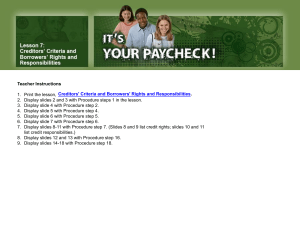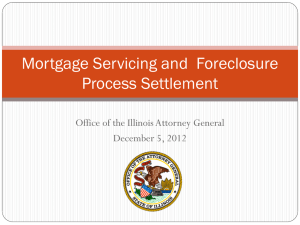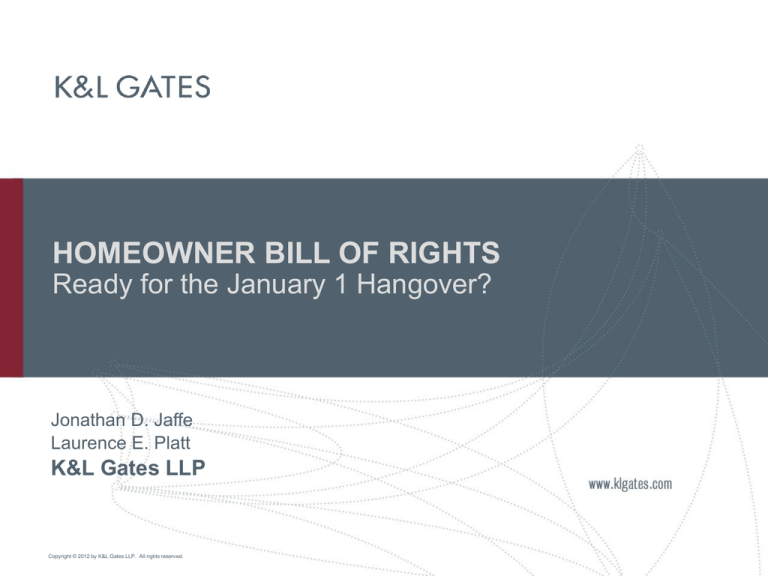
HOMEOWNER BILL OF RIGHTS
Ready for the January 1 Hangover?
Jonathan D. Jaffe
Laurence E. Platt
K&L Gates LLP
Copyright © 2012 by K&L Gates LLP. All rights reserved.
Prelude to Homeowner Bill of Rights
On February 9, 2012, five of the largest banks entered into a
$26 Billion National Mortgage Servicing Settlement Agreement
(“NMS”) with 49 state attorneys general (including California)
and a number of federal regulatory agencies
Less than 2 weeks later, Attorney General Kamala Harris and
some senior legislators announced the “California Homeowner
Bill of Rights,” designed to make permanent in California
many of the aspects of the NMS
The bills were moved from the regular legislative process to a
conference committee, resulting in a very expedited process
with limited input from the industry
2
Five Bills
The Foreclosure Reduction Act Of 2012 - AB
278 / SB 900
Blight Prevention - AB 2314
Tenant Protection - AB 2610
Enhancement Of Attorney General Enforcement
Act - AB 1950
Attorney General Special Grand Jury Act - SB
1474
3
The Foreclosure Reduction Act (“FRA”) –
General
SB 1137 - Amends and supplements 2008 emergency
legislation that implemented three categories of borrower and
tenant protections
Imposed mandatory notification, meeting and consultation
process that foreclosing lenders/servicers were required to
make available to borrowers prior to filing a notice of default
(“NOD”)
Also required REO owners to give tenants of foreclosed
residential property a minimum of 60 days’ written notice to
quit, before evicting them
Authorized local governments to impose civil fines of up to
$1,000 per day for failure of a lender or other purchaser in
foreclosure to maintain vacant residential property in good
condition and repair
4
The Foreclosure Reduction Act (“FRA”) –
General (cont’d)
Who’s Covered - Places burden of compliance on the
“mortgage servicer” - the person who directly services the loan
or is responsible for interacting with the borrower, managing
any escrow account, or enforcing the loan, either as the
current owner of the note or as the owner’s agent
Covers master servicers, owners/servicers, subservicers
Terminology in bills not always consistent - sometimes
“mortgage servicer,” sometimes “mortgagee, trustee,
beneficiary, or authorized agent,” and sometimes
combinations
Doesn’t cover trustees, or authorized agent of a trustee,
acting under “deed of trust” (“DOT”)
5
The Foreclosure Reduction Act (“FRA”) –
General (cont’d)
Large and Small Servicers - The FRA distinguishes between
(a) regulated/licensed lenders/servicers that conduct 175 or
fewer California residential mortgage foreclosures during
immediately preceding annual reporting period as established
by its primary regulator (“Smaller Servicers”), and (b) other
lenders/servicers (“Larger Servicers”)
Procedures applicable to Larger Servicers are much
more detailed
SB 900 limits application of following to Larger Servicers:
contacting the borrower prior to default, dual tracking,
single point of contact, and some private right of action
provisions
6
The Foreclosure Reduction Act (“FRA”) –
General (cont’d)
Loans Covered - First lien, consumer purpose residential
mortgage loans secured by a one-to-four family residence,
owner occupied, with borrow who is natural person and the
trustor (subject to very limited exceptions)
Unlike SB 1137, not limited to loans made between 20032007
7
The Foreclosure Reduction Act (“FRA”) –
General (cont’d)
Initiating Foreclosure – Only holder of a beneficial interest
under the DOT, the holder's designated agent, or the trustee
under the DOT may initiate nonjudicial foreclosure
No agent of the holder of the beneficial interest or trustee
may record an NOD or otherwise commence foreclosure
proceedings unless they are acting within the scope of
authority designated by the holder of the beneficial
interest
This requirement applies to all loans, not just residential
mortgage loans
8
The Foreclosure Reduction Act (“FRA”) –
General (cont’d)
Sunset – In numerous places HOBR contains
alternative sections
One version in effect from 1/1/2013 through
1/1/2018, and another on and after 1/1/2018
Where to Find – HOBR is found in 16 sections of
the Civil Code, with the same subject sometimes
addressed in multiple sections
9
The Foreclosure Reduction Act – Notices
Mortgage servicer, mortgagee, trustee, beneficiary
or authorized agent may not record an NOD until 30
days after:
Initial contact, following existing SB 1137 protocols e.g., assessing borrower’s financial situation and
exploring options for foreclosure avoidance, or
Servicer satisfies due diligence requirements to
attempt to locate borrower with no borrower
response, again following SB 1137 protocols
A new declaration of compliance must be attached to the
NOD
10
The Foreclosure Reduction Act – Notices
(cont’d)
Upon borrower request for foreclosure prevention alternative,
servicer must establish a single point of contact (“SPOC”) and
provide borrower with one or more direct means of
communication with the SPOC
Larger Servicers must also inform the borrower in a pre-NOD
outreach package:
Of any applicable protections provided under the SCRA
That borrower may request copies of the note, deed of
trust, assignments of the deed of trust, and a payment
history as of the date the borrower was last less than 60
days delinquent
11
The Foreclosure Reduction Act –
Loan Mods and Dual Tracking
Larger Servicers subject to loan mod provisions in Sections
2923.55, 2923.6, 2923.7, 2924.9, 2924.10 and 2924.11
There’s some overlap and internal inconsistencies
Restricts dual tracking (i.e., servicer forecloses while
application for a loan modification is pending)
In some places HOBR refers to “first lien loan
modifications,” while in others to “foreclosure prevention
alternatives” (defined in Section 2920.5(b) as a “first lien
loan modification or another available loss mitigation
option”)
Unclear whether the Legislature intended different
meanings
12
The Foreclosure Reduction Act –
Loan Mods and Dual Tracking (cont’d)
HOBR says no particular result required under loss mit
process
Keeps SB 1137 requirements, but requires more of servicer in
handling borrower loan mod requests, including appeal
process if denial
Unless borrower previously exhausted the loan mod process,
servicer that offers one or more foreclosure prevention
alternatives must, within 5 business days after recording an
NOD, send borrower written communication informing that
borrower may be evaluated for a foreclosure prevention
alternative and describing the application process
Upon borrower request for a foreclosure prevention
alternative, mortgage servicer must promptly establish an
SPOC
13
The Foreclosure Reduction Act –
Loan Mods and Dual Tracking (cont’d)
When borrower submits a “complete” first lien modification
application - or any document in connection with a first lien
modification application - mortgage servicer must: provide
written acknowledgment of receipt within 5 business days,
describe loan mod process, state any deadlines, and identify
any deficiencies in the documents submitted by the borrower.
Question whether this acknowledgement applies after receipt
of any document received after receipt of initial application.
14
The Foreclosure Reduction Act –
Loan Mods and Dual Tracking (cont’d)
Servicer may not record an NOD or Notice of Sale (“NOS”) or
conduct a trustee’s sale while the application is pending, or
until any of the following occurs: (1) servicer makes a written
determination that the borrower is not eligible for the mod, and
the applicable appeal period has expired; (2) the borrower
does not accept an offered mod within 14 days of the offer; or
(3) the borrower accepts an offered mod but breaches his
obligations under the mod
Application deemed “complete” when a borrower has supplied
servicer with all required documents within reasonable
timeframes specified by the servicer
15
The Foreclosure Reduction Act –
Loan Mods and Dual Tracking (cont’d)
Servicer must send borrower written notice of denial of loan
mod, including information on: (1) the reasons for denial; (2)
borrower’s appeal rights; and (3) if applicable, a description of
other foreclosure prevention alternatives “for which the
borrower may be eligible,” and steps borrower must take to be
considered for those options
Convoluted, unclear language that is likely to result in
questions as to how many times a servicer must
consider an application for a foreclosure prevention
alternative
16
The Foreclosure Reduction Act –
Loan Mods and Dual Tracking (cont’d)
If the borrower’s application is approved, the lender may not
record an NOD or NOS while the borrower is in compliance
with its terms
Servicer must record a rescission of an NOD or cancel a
pending trustee’s sale upon the borrower executing a
permanent foreclosure prevention alternative
If short sale, rescission/cancellation must occur when
sale has been approved by all parties and lender has
received proof of funds or financing
17
The Foreclosure Reduction Act –
Loan Mods and Dual Tracking (cont’d)
Servicer may not charge any application, processing, or
other fee for a first lien loan modification or other
foreclosure prevention alternative
While a foreclosure prevention alternative is being
considered, or denial is being appealed, servicer may not
collect late fees
Within 5 business days following a postponement of a
foreclosure sale for 10 or more business days, the
mortgagee must provide written notice to the borrower
regarding the new sale date and time
18
The Foreclosure Reduction Act –
Single Point of Contact
Mandates that Larger Servicers provide an SPOC for the
borrower if the borrower applies for a foreclosure prevention
alternative, and must provide borrower with one or more direct
means of communication with their SPOC
Likely that servicers will build this in at time of initial
contact and throughout default process
SPOC is satisfied by an individual or team of individuals,
provided each team member has knowledge of the
borrower’s status and remains with the borrower
throughout the pre-foreclosure process
19
The Foreclosure Reduction Act –
Robosigning
All documents filed in support of a foreclosure must
be verified for accuracy, complete, and supported by
competent and reliable evidence
Includes NODs, supporting declarations
(including declarations recorded pursuant to
Civil Code §§ 2923.5 or 2923.55), NOSs,
assignments of DOTs, and Substitutions of
Trustee recorded in connection with a
nonjudicial foreclosure, as well as declarations
filed in court with respect to any foreclosure
proceeding
20
The Foreclosure Reduction Act –
Robosigning (cont’d)
Mortgage servicers that engage in multiple and
repeated unverified signings of foreclosure
documents - “robosigning” – are subject to a $7,500
civil money penalty per DOT
May be levied by a government entity, including
the primary California regulator or licensing
agency
No private right of action
21
The Foreclosure Reduction Act –
Private Right of Action
Provides a private right of action (“PRA”) for “material”
violations, e.g., failing to provide a SPOC, processing a
dual-track foreclosure, etc.
PRA available against Smaller Servicers for material
violations of Sections 2923.5, 2924.17 or 2924.18, and
against Larger Servicers for material violations of
Sections 2923.55, 2923.6, 2923.7, 2924.9, 2924.10,
2924.11, or 2924.17
22
The Foreclosure Reduction Act –
Private Right of Action (cont’d)
If the property has not been sold, the borrower may sue
to enjoin the sale and seek attorney fees for material
violations
Servicer may seek to dissolve the injunction if it
corrects and remedies material violation
Servicer, mortgagee, trustee, beneficiary, or authorized
agent can avoid liability for any violation corrected and
remedied prior to recordation of a trustee's deed upon
sale
23
The Foreclosure Reduction Act –
Private Right of Action (cont’d)
If the property has been sold, the borrower may sue in civil
court for actual economic damages resulting from material
violation, plus attorney fees
If the violation was willful, intentional or reckless, the court
may award the borrower the higher of $50,000 or treble actual
damages
This is in addition to any other rights, remedies, or procedures
available under any other law
A violation is deemed a violation of the servicer’s charter or
license, so subject to agency administrative enforcement
In theory, could include loss of license
24
National Mortgage Settlement
National Servicing Standards
Foreclosure Information and Documentation
Third-Party Provider Oversight
Dual Track Foreclosures
Single Point of Contact
Online Loan Portal
Loan Mod Timelines
Independent Evaluation of Mod Denials
Transfer of Servicing
Protections for Military Personnel
Servicing Fees
25
National Mortgage Settlement (cont’d)
Loan Modification Requirements, Foreclosure
Information and Documentation
Consumer Relief Requirements
Principal Reduction
First-Lien Mods
Second-Lien Portfolio Mods
Actions by Subservicers
26
National Mortgage Settlement (cont’d)
Refinance and Other Loss Mitigation Requirements
Short Sales
Deficiency Waivers
Forbearance for Unemployed Borrowers
27
National Mortgage Settlement (cont’d)
Enforcement
Settlement Monitor
Internal Review Group
Quarterly Reports
Potential Violations and Right to Cure
Releases from Liability
Implementation by Servicers
28
Tenant Protection – AB 2610
Expands state law to protect tenants in a foreclosed
property from eviction for 90 days following a sale of
the home
Also requires purchasers of a rental property in a
foreclosure sale to honor tenant’s existing fixed
lease, unless the new owner plans to make the
property her principal residence or the tenant is the
original mortgagor
29
Blight Prevention - AB 2314
Removes the sunset provision from laws allowing
local governments to fine owners of blighted
property by up to $1,000 per day
The law also extends the grace period for owners to
correct the problem to 60 days for those who
purchased a foreclosed home after 2008
Also gives receivers the ability to seek a court order
ordering the blighted property’s owner to pay these
unrecovered costs
30
Enhancement Of Attorney General
Enforcement Act - AB 1950
Permanently prohibits businesses from charging an
up-front fee for mortgage renegotiation services
Also expands the state statute of limitations to three
years for the prosecution of these provisions
31
Attorney General Special Grand Jury Act –
SB 1474
Authorizes California AG to convene a special grand
jury to investigate and indict perpetrators of financial
crimes involving victims in multiple jurisdictions
32
Introducing our Blog
For news and developments related to
consumer financial products and services,
please visit our blog at
www.consumerfinancialserviceswatch.com
and subscribe to receive updates.
33
Thank you
Jonathan D. Jaffe
415 249-1023
jonathan.jaffe@klgates.com
Laurence Platt
202 778-9034
larry.platt@klgates.com
www.klgates.com
34


